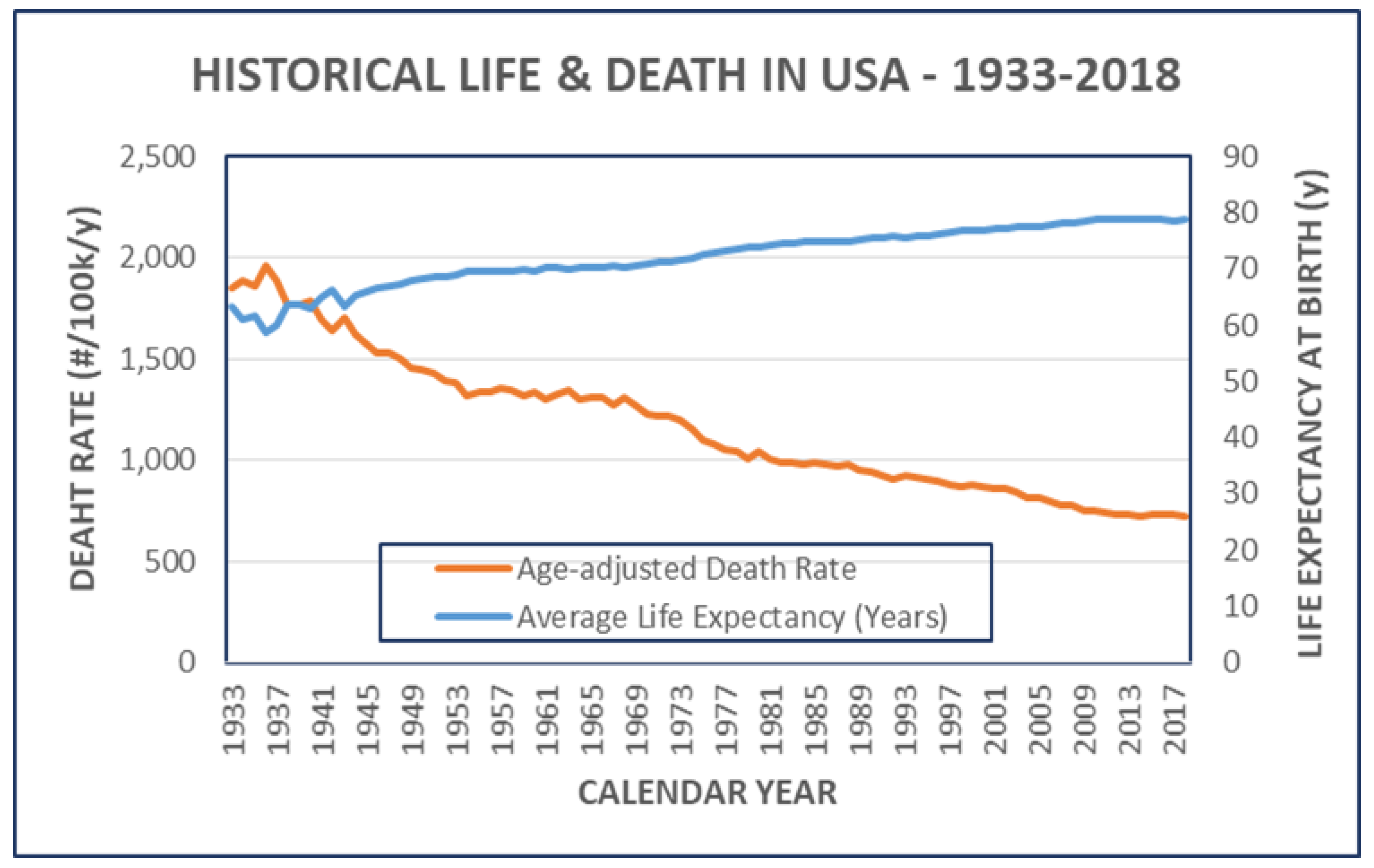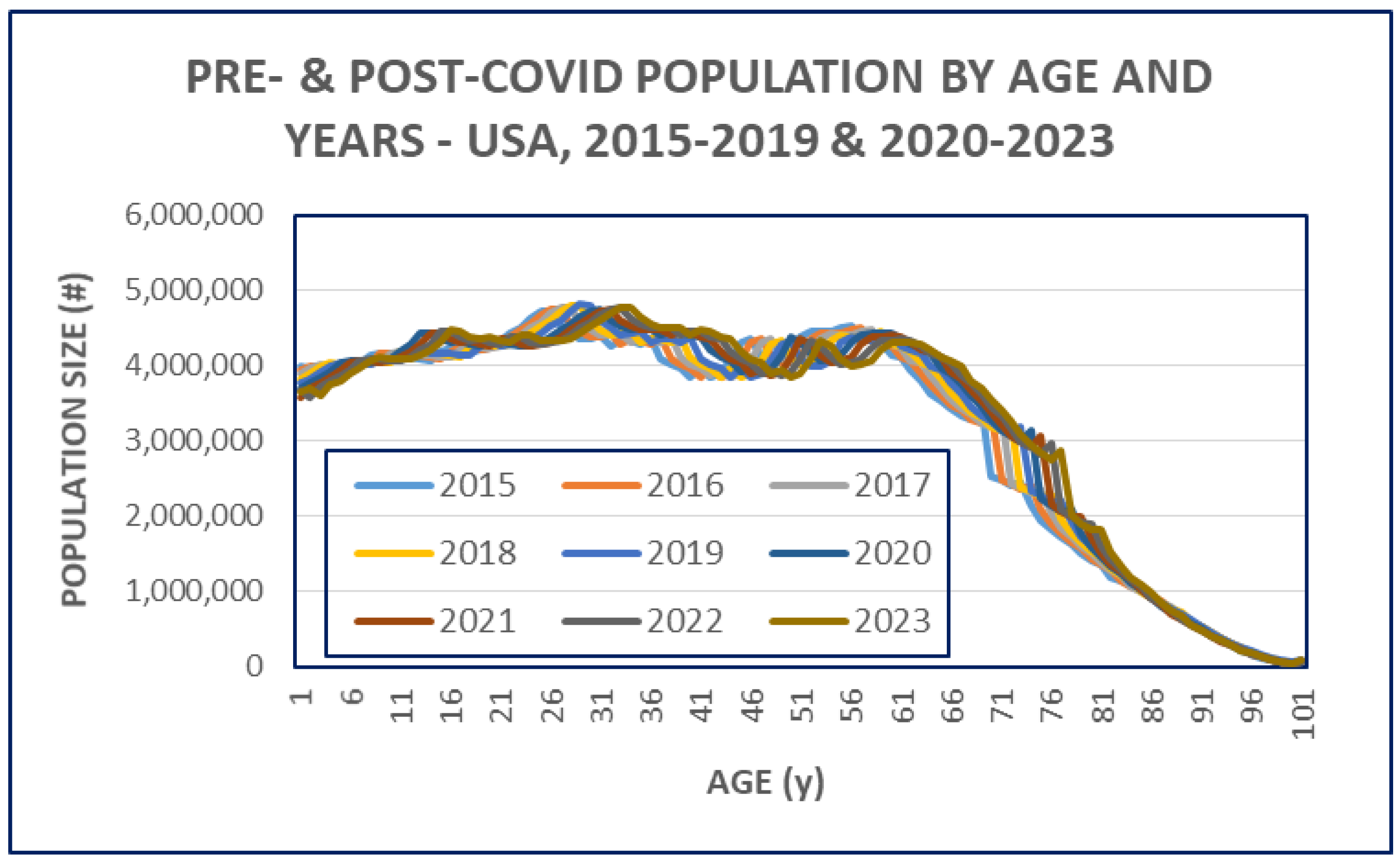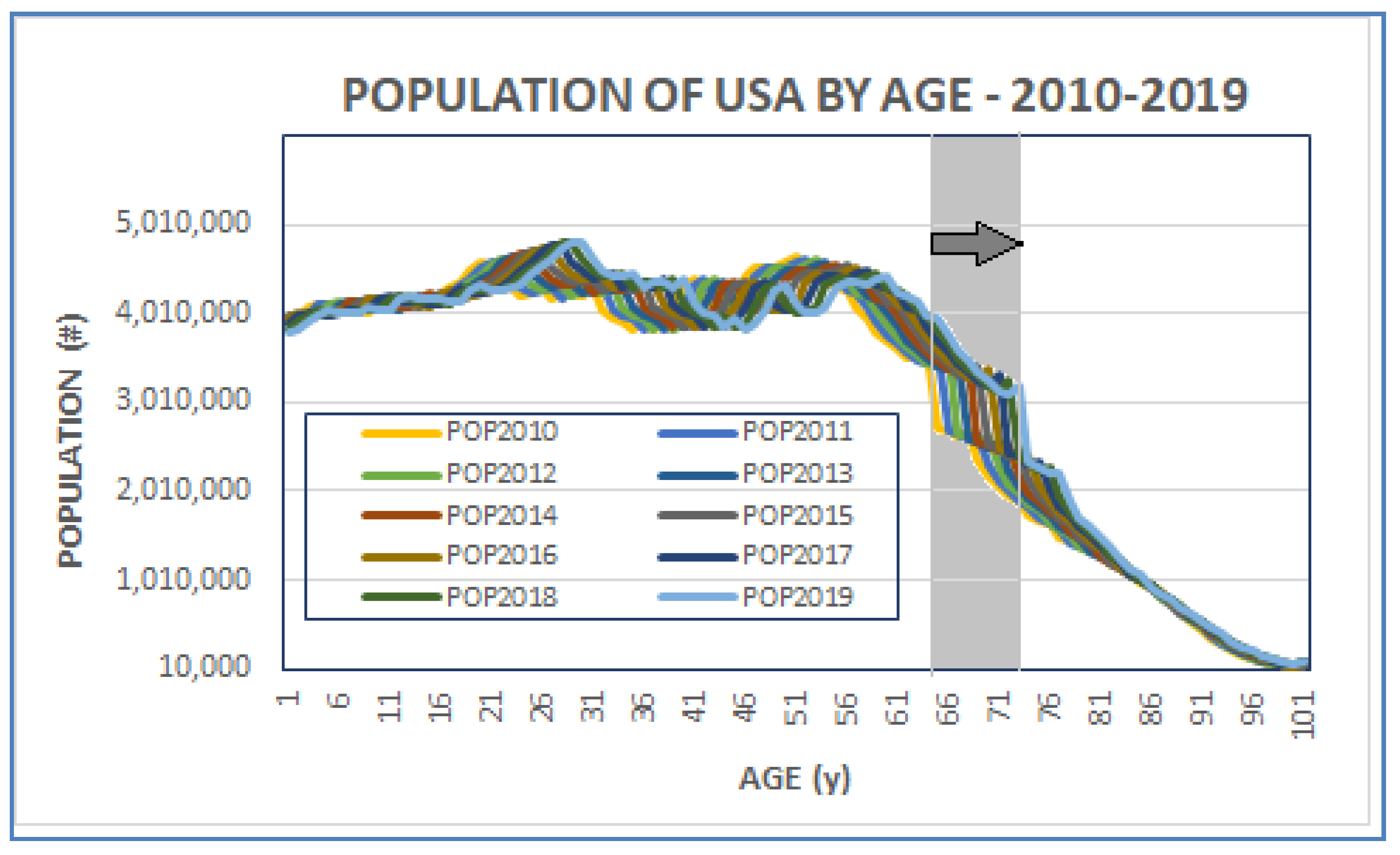Submitted:
15 September 2024
Posted:
16 September 2024
You are already at the latest version
Abstract
Keywords:
Introduction
Methods
Results
A. BIOLOGICAL PARAMETERS OF LIFE IN USA
- 1.
- General Life expectancy
- -
- Initial Life Expectancy (ILE) [9]: It is the expected number of years alive at the moment of birth;
- -
- Residual Life Expectancy (RLE) [10] : It is the expected number of years alive at a certain age;
- -
- Accomplished Life Expectancy (ALE): It is the final number of years alive at the moment of deaths. This parameter describes how well a person succeeded to live until the statistically expected (average) lifetime.
- 2.
- Age Normalized Death Rates, MR(i)
- The successive increase of the expectable years of individual lives - and the associated decrease of the MRs – was continuous, almost a century, without major variation (Figure 1).

B. SOCIO- ECONOMIC PARAMETERS OF ‘LONGEVITY’
- 1.
- The ‘value’ of life.
- 2.
- The ‘price’ of increasing RLE (longevity).
- -
- Survival and prosperity through reproduction: this is the original, collectivistic way of staying alive by propagating your individual chromosomes. This method is often the only one available.
- -
- Survival and prosperity through longevity: this might be called the egoistic way, because it is based on concentrating the life experience in fewer number of individuals instead of dispersing it to many descendants.


- 3.
- Calculation of the cost/benefit ratio of a rational health care.

C. THE INTERFERENCE OF COVID PANDEMIC WITH THE NORMAL LIFE OF AMERICANS
- 1.
- Excess Mortality [XM] during the Coronavirus pandemic (COVID-19) [15]
- Globally, the total number of excess deaths is estimated to be two to four times higher than the reported number of confirmed deaths due to COVID-19 (incl. both deaths confirmed by specific laboratory (viral) test or not [16]). The WHO confirmed [17] that the total number of excess deaths is substantially higher than the number of confirmed deaths due to COVID-19. Consequently the XM is the sum of two distinct categories
- a.
-
Total Covid Deaths (TCD) category contains cases there close connection to virus had been established, reported and became part of the COVID statistic:
- -
- there the Covid virus was the Underlying Couse of Death (UCOD) and it was confirmed by specific laboratory viral test (true Covid Deaths – [CD+]) and
- -
- there the Covid was suspected as contributor to the deaths but it hadn’t been confirmed by viral test (‘hearsay’ Covid Deaths – [CD?]) [5].
- b.
- Complementary Covid Deaths (CCD) category contains all kinds of excess deaths which occurred under the pandemic but association to Covid virus itself was not possible to establish and it hadn’t been part of the official Covid statistic. It is speculated that CCM is the result of life changing conditions associated with the extensive COVID regulations rather than the virus itself [18].
- 2.
- Effect on the Size of the Population in USA

- 3.
- Effect on the Detailed Mortality Parameters
- -
- Relying on the official definition - that pools the ‘true’ [CD+] cases with the un-supported ‘hearsay’-based causes [CD?] - the CCD/XCD ratio is starting ~35% but increasing to ~ 60% by time. (Upper part of Table 3 and Figure 9A)
- -
- Using the evidence-based definition, that requests that the diagnosis is substantiated by specific laboratory viral test, the count of true-COVID deaths [CD+] is lower than reported and the corresponding CCD is higher: the CCD/XCD ratio is starting at ~ 50% with a slight increase by the years (~60%). (Lower part of Table III and Figure 9B).


- 4.
- Effects on the Economy of the USA (short- and long-term)
 |
- 5.
- Effects on the ‘Perception’ of the Constitutional Structure and Laws of the USA
- COVID is a syndemic [19].
- b.
- Heterodoxy of COVID-19 [20].
- c.
- COVID induced ‘nocebo’ effects [22].
- d.
Discussion
Conclusions & Summary
- -
- the value of “longevity” is increasing and it is already high in the USA;
- -
- The costs of longevity is extremely high in USA compared to well-developed west-European countries;
- -
- The COVID pandemic threatened the largest and most profitable market of the American health-care industry by accelerating the natural death process of elderly and seriously sick persons;
- -
- The state enforced defense policy was life-saving for the medical-pharmaceutical industry;
- -
- The benefit-cost ration of the pandemic rules is not uplifting, especially not when, it seems to be, that as much persons died due to the dramatic changes in life style (lockdown, isolation, et cet.) than as the result of the direct COVID disease.
Acknowledgement
Conflict of Interest
Abbreviations
| 14+ | ||
| TCD | Total COVID Deaths | # |
| TCM | Total COVID Mortality | ratio |
| CCD | Complementary COVID Deaths | # |
| [CD+] | ‘true’ COVID Deaths confirmed by viral test | # |
| [CD?] | ‘hearsay’ COVID Deaths, not confirmed by viral test | # |
| [CD+/?] | pooled ‘true’ & ‘hearsay’ COVID deaths | # |
| XD | eXtra or eXcess Deaths | # |
| XCD | eXtra or eXcess COVID associated Deaths | # |
| XCM | Excess COVID Mortality | ratio |
| R | Reported | # |
| P | Predicted | # |
| UCOD | Underlying Couse Of Death | n. a |
| RLE | Residual Life Expectancy | years |
| ILE | Initial Life Expectancy | years |
| ALE | Accomplished Life Expectancy | years |
| MR | Mortality (death) Rate | ratio |
| TRD | Total counts of Reported Deaths | # |
| TPD | Total Projected (or expected) Deaths of all causes | # |
References
- https://www.paul.senate.gov/wp-content/uploads/2023/08/FILE_7353.pdf.
- Case 2:20-cv-00966-NR Document 4 Filed 06/29/20 - https://www.brennancenter.org/sites/default/files/2020-07/Trump%20Complaint.pdf.
- Press release by the Office of Attorney General of Texas on November 30, 2023. - https://texasattorneygeneral.gov/news/releases/attorney-general-ken-paxton-sues-pfizer-misrepresenting-covid-19-vaccine-efficacy-and-conspiring & [District Court of Lubbock County, TX, CIVIL DOCKET FOR CASE #: 5:23-cv-00312-C, filed Nov. 30, 2023] .
- PROJECT VERITAS FILMS PFIZER DIRECTOR OF R&D SAYING ‘MUTATING’ COVID-19 FOR NEW VACCINES IS UNDER CONSIDERATION - Jan 25, 2023.
- Biro JC: CRITICAL REVIEW OF THE DIAGNOSTIC AND STATISTICAL SUPPORT FOR COVID EPIDEMIC IN USA - JMIR Preprints. 18/05/2024:60679 - URL: https://preprints.jmir.org/preprint/60679. [CrossRef]
- Florida Department of Health - January 03, 2024 - a https://www.floridahealth.gov/newsroom/2024/01/20240103-halt-use-covid19-mrna-vaccines.pr.htm l.
- STATE OF KANSAS, ex rel., KRIS W. KOBACH, Attorney General, - Plaintiff, v.PFIZER INC., - Defendant.: Petition – 2024.06.17 - https://ag.ks.gov/docs/default-source/documents/2024-06-15-pfizer-complaint-(002).pdf.
- It was the legendary life length of Moses – the Jewish Prophet.
- The author’s terminology.
- The author’s terminology.
- Like the market value of Leonardo da Vinci-s Mona Lisa, hanged in the Louvre Museum forever. Living long or forever is one of the wildest phantasies of the Homo sapiens. Just to mention some variations in the subject: “aqua vitae”, “fountain of youth”, “philosopher’s stone”, “and elixir of life”. The religious concept of “afterlife” is probably one of the most powerful ideas of living-for-ever.
- Esteban Ortiz-Ospina and Max Roser (2017) - “Healthcare Spending” Published online at OurWor.
- The Year in Healthcare Charts. Available from: http://www.forbes.com/sites/danmunro/2012/12/30/2012-the-year-in-healthcare-charts/#33337736458f.
- SOURCE: Centers for Medicare and Medicaid Services, Office of the Actuary, National Health Statistics Group.- https://www.cms.gov/data-research/statistics-trends-and-reports/national-health-expenditure-data/state-residence dInData.org - https://ourworldindata.org/financing-healthcare.
- E. Mathieu, et al.: (2020) - "Coronavirus Pandemic (COVID-19)". Published online at OurWorldInData.org. Retrieved from: https://ourworldindata.org/coronavirus.
- Wang, H., et al. (2022). Estimating excess mortality due to the COVID-19 pandemic: a systematic analysis of COVID-19-related mortality, 2020–21. The Lancet.- from: https://ourworldindata.org/coronavirus.
- Methods for estimating the excess mortality associated with the COVID-19 pandemic – WHO - 19 May 2023 - https://www.who.int/publications/m/item/methods-for-estimating-the-excess-mortality-associatedwith-the-covid-19-pandemic .
- Publications often not distinguish CCM from TCM as a separate category of XCM and ignoring the ‘man-made’ (human) contributions to the consequences of the pandemic.
- Shelke A, Shelke S, Acharya S, et al. (November 05, 2023) Synergistic Epidemic or Syndemic: An Emerging Pattern of Human Diseases. Cureus - 15(11): e48286. - https://pubmed.ncbi.nlm.nih.gov/38058320/. [CrossRef]
- Yaffa Shir-Raz at. Al. - Censorship and Suppression of Covid-19 Heterodoxy: Ta.ctics and Counter-Tactics - Minerva (2023) 61:407–433 - https://link.springer.com/article/10.1007/s11024-022-09479-4. [CrossRef]
- John P. A. Ioannidis - Coronavirus disease 2019: The harms of exaggerated information and non-evidence-based measures – Editorial - Eur J Clin Invest. 2020;50:e13222. - https://doi.org/10.1111/eci.13222 - https://www.ncbi.nlm.nih.gov/pmc/articles/PMC7163529/pdf/ECI-50-e13222.pdf.
- Philipp Bagus, José Antonio Peña-Ramos, and Antonio Sánchez-Bayón, “COVID-19 and the Political Economy of Mass Hysteria,” International Journal of Environmental Research and Public Health 18, no. 4 (2021): 1376. [CrossRef]
- Philipp Bagus, José Antonio Peña-Ramos, Antonio Sánchez-Bayón: Capitalism, COVID-19 and lockdowns - Business Ethics, Env & Resp. 2023;32:41–51. https://onlinelibrary.wiley.com/doi/pdf/10.1111/beer.12431. [CrossRef]
- Hart PS, Chinn S, Soroka S. Politicization and Polarization in COVID-19 News Coverage. Sci Commun. 2020 Oct;42(5):679-697. [CrossRef] [PubMed] [PubMed Central]
- Stroebe W, et al: Politicization of COVID-19 health-protective behaviors in the United States: Longitudinal and cross-national evidence. PLoS One. 2021 Oct 20;16(10):e0256740. [CrossRef]
- AMA Code of Medical Ethics - https://code-medical-ethics.ama-assn.org/.





 |
 |
 |
Disclaimer/Publisher’s Note: The statements, opinions and data contained in all publications are solely those of the individual author(s) and contributor(s) and not of MDPI and/or the editor(s). MDPI and/or the editor(s) disclaim responsibility for any injury to people or property resulting from any ideas, methods, instructions or products referred to in the content. |
© 2024 by the authors. Licensee MDPI, Basel, Switzerland. This article is an open access article distributed under the terms and conditions of the Creative Commons Attribution (CC BY) license (http://creativecommons.org/licenses/by/4.0/).





